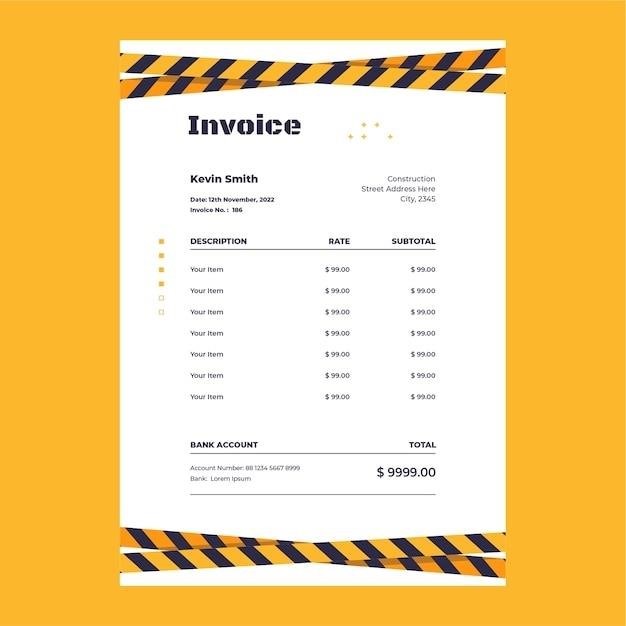Overhead Crane Inspection Checklist PDF⁚ A Comprehensive Guide
This comprehensive guide provides an in-depth overview of overhead crane inspection checklists‚ covering their importance‚ types‚ OSHA regulations‚ components‚ and practical tips for effective inspections; It also includes a sample checklist and resources for further information and training.
Introduction
Overhead cranes are essential equipment in various industries‚ playing a crucial role in lifting‚ transporting‚ and positioning heavy loads. Ensuring their safe and reliable operation is paramount to prevent accidents‚ injuries‚ and costly downtime. A comprehensive overhead crane inspection checklist serves as a vital tool for identifying potential hazards and ensuring compliance with safety regulations. This checklist acts as a structured guide for inspecting various components of the crane‚ including its structural integrity‚ lifting mechanism‚ electrical system‚ and safety devices. By systematically evaluating these elements‚ organizations can proactively mitigate risks‚ minimize maintenance costs‚ and enhance workplace safety.
Importance of Overhead Crane Inspections
Regular and thorough inspections of overhead cranes are essential for safeguarding workers‚ protecting equipment‚ and ensuring operational efficiency. Inspections help identify potential hazards‚ such as worn components‚ faulty wiring‚ or compromised structural integrity‚ before they escalate into serious accidents or malfunctions. By detecting and addressing issues early‚ organizations can prevent costly repairs‚ downtime‚ and potential injuries. Additionally‚ inspections demonstrate a commitment to safety‚ compliance with regulations‚ and a proactive approach to risk management. This fosters a culture of safety within the workplace‚ ultimately contributing to a healthier and more productive environment.
Types of Overhead Crane Inspections
Overhead crane inspections are categorized by frequency and scope‚ each tailored to address specific aspects of the crane’s condition. Daily inspections are conducted by the operator before each shift‚ focusing on visual checks for obvious defects‚ fluid levels‚ and general functionality. Weekly inspections involve a more thorough examination of key components‚ including wire ropes‚ brakes‚ and lifting mechanisms. Monthly inspections delve deeper into lubrication‚ electrical systems‚ and structural integrity. Annual inspections‚ conducted by qualified professionals‚ encompass comprehensive assessments of all crane components‚ including non-destructive testing and detailed documentation.
Daily Inspections
Daily inspections are the cornerstone of overhead crane safety‚ conducted by the operator before each shift. These inspections are quick and focused on identifying immediate hazards. The operator visually examines the crane for any obvious defects‚ such as cracks‚ loose bolts‚ or damaged components. They check fluid levels in hydraulic systems and ensure the crane’s general functionality‚ including hoisting‚ traversing‚ and braking. Daily inspections also involve verifying the presence and condition of safety devices like limit switches and overload protection systems. These crucial checks help prevent accidents and ensure the crane is operating safely and efficiently.
Weekly Inspections
Weekly inspections delve deeper into the crane’s condition‚ going beyond the visual checks of daily inspections. These inspections typically involve a qualified inspector who thoroughly examines the crane’s structural components‚ including the bridge‚ trolley‚ and hoisting mechanism. They assess wear and tear on gears‚ bearings‚ and other moving parts. The inspector also checks the electrical system for signs of damage or deterioration. Weekly inspections may also include testing the crane’s braking system and reviewing the condition of wire ropes and attachments. These more in-depth checks ensure the crane’s continued safe operation and identify potential issues before they become major problems.
Monthly Inspections
Monthly inspections expand upon the thoroughness of weekly inspections‚ focusing on a more in-depth analysis of the crane’s overall condition. These inspections often involve a certified inspector who conducts a comprehensive review of the crane’s structural integrity‚ including its supporting beams‚ girders‚ and connections. They meticulously examine the hoisting mechanisms‚ inspecting the gears‚ bearings‚ and other moving parts for signs of wear or damage. The inspector also carefully scrutinizes the electrical system‚ checking for any potential hazards or deterioration. Monthly inspections typically include a detailed evaluation of the crane’s braking system‚ ensuring its functionality and responsiveness. They also assess the condition of wire ropes and attachments‚ looking for signs of fraying‚ corrosion‚ or damage.
Annual Inspections
Annual inspections are the most comprehensive and crucial type of overhead crane inspection‚ demanding the expertise of a qualified inspector. These inspections involve a thorough examination of every aspect of the crane‚ including its structural components‚ hoisting mechanisms‚ electrical system‚ braking system‚ and wire ropes. The inspector meticulously reviews the crane’s documentation‚ verifying its compliance with safety regulations and manufacturer’s specifications. Annual inspections typically include a thorough evaluation of the crane’s load capacity‚ ensuring it can safely handle its intended loads. They also assess the condition of the crane’s safety devices‚ such as limit switches‚ overload protection‚ and emergency stops. The inspector carefully evaluates the crane’s operating environment‚ identifying any potential hazards or factors that could impact its safety. Annual inspections are essential for maintaining the crane’s operational integrity‚ ensuring its continued safe and reliable performance.
OSHA Regulations for Overhead Crane Inspections
The Occupational Safety and Health Administration (OSHA) plays a crucial role in ensuring the safety of overhead cranes‚ implementing stringent regulations to minimize workplace accidents. OSHA’s regulations‚ outlined in 29 CFR 1910.179‚ mandate comprehensive inspection programs for overhead cranes‚ emphasizing the importance of regular inspections and maintenance. These regulations specify the frequency of inspections‚ ranging from daily checks for crane operators to annual inspections conducted by qualified professionals. OSHA regulations cover various aspects of overhead crane inspections‚ including the visual examination of structural components‚ hoisting mechanisms‚ electrical systems‚ braking systems‚ and wire ropes. They also address the documentation of inspection findings‚ requiring detailed records of any defects or deficiencies identified. OSHA’s regulations are designed to ensure that overhead cranes are maintained in a safe and operational condition‚ minimizing the risk of accidents and injuries in the workplace.
Components of an Overhead Crane Inspection Checklist
A comprehensive overhead crane inspection checklist encompasses a wide range of critical components‚ ensuring a thorough assessment of the crane’s overall condition and safety. These components typically include a detailed evaluation of the crane’s general condition‚ structural integrity‚ hoisting and lifting mechanisms‚ electrical system‚ braking and safety devices‚ and wire rope and attachments. The checklist should assess the visual appearance‚ functionality‚ and wear and tear of each component‚ noting any signs of damage‚ corrosion‚ or malfunction. The inspection should also verify the proper operation of safety devices‚ such as limit switches‚ overload protection‚ and emergency stops. A thorough inspection of the wire rope‚ including its diameter‚ wear‚ and lubrication‚ is crucial to ensure its strength and integrity. By meticulously inspecting each component‚ organizations can proactively identify potential hazards and address them before they escalate into serious safety issues;
General Condition
The general condition assessment of an overhead crane focuses on its overall appearance and functionality. This component of the checklist requires a visual inspection of the crane’s structure‚ including its frame‚ beams‚ and supports. Inspectors should look for signs of damage‚ such as cracks‚ dents‚ or corrosion‚ and ensure that all bolts and fasteners are secure. The condition of the crane’s paint and protective coatings should also be assessed to identify any areas of deterioration. The checklist should also verify the functionality of the crane’s controls‚ including the hoist‚ trolley‚ and bridge travel mechanisms. The operator’s cab and its components‚ such as the seat‚ controls‚ and emergency stop button‚ should be inspected for any signs of wear or damage. This comprehensive review of the crane’s general condition helps ensure a safe and efficient operation.
Structural Components
The structural components of an overhead crane are crucial for its stability and safe operation. The inspection checklist should include a thorough examination of the crane’s main structural elements‚ such as the bridge‚ trolley‚ and end trucks. Inspectors should look for signs of wear‚ damage‚ or distortion in these components. This includes checking for cracks‚ welds‚ or other defects in the steel structure. The condition of the crane’s bearings and wheels should also be assessed‚ ensuring they are properly lubricated and free from excessive wear or damage. The checklist should also verify the integrity of the crane’s supporting beams‚ columns‚ and other structural elements‚ ensuring that they are securely anchored and capable of supporting the crane’s load capacity. The inspection should also include a visual assessment of the crane’s runway beams and supports‚ ensuring that they are free from any signs of deformation or damage. This comprehensive inspection of the crane’s structural components is essential for maintaining its stability‚ safety‚ and longevity.
Hoist and Lifting Mechanism
The hoist and lifting mechanism are the heart of an overhead crane‚ responsible for lifting and moving loads. A thorough inspection of these components is crucial for safety. The checklist should include a detailed examination of the hoist motor‚ gears‚ and bearings‚ ensuring they are functioning properly and free from excessive wear or damage; The condition of the hoist chain or wire rope should be carefully inspected for signs of wear‚ fraying‚ or broken strands. The inspection should also include a check of the hoist’s brake system‚ ensuring it is functioning properly and capable of safely stopping the load. The hoist’s limit switches‚ designed to prevent overloads and excessive travel‚ should be tested to ensure they are operating correctly. The condition of the hoist’s hook and other lifting attachments should also be assessed‚ looking for any signs of damage‚ deformation‚ or wear. This comprehensive inspection of the hoist and lifting mechanism is essential for ensuring the safe and reliable operation of the overhead crane.
Electrical System
The electrical system of an overhead crane is a complex network of components that power its operation. A thorough inspection of this system is vital to ensure safe and reliable operation. The checklist should include a visual inspection of all electrical wiring‚ cables‚ and connections‚ looking for signs of damage‚ wear‚ or loose connections. The condition of the electrical control panel and its components‚ including switches‚ relays‚ and fuses‚ should be carefully examined. The operation of the electrical brakes and safety devices should be tested to ensure they are functioning properly and preventing potential hazards. The insulation of electrical components should be checked for signs of deterioration or damage. Any frayed or exposed wires should be immediately repaired. The grounding system should be inspected to ensure it is properly connected and functioning as intended. This comprehensive inspection of the electrical system will help identify potential electrical hazards and ensure the crane’s safe operation.
Brakes and Safety Devices
The brakes and safety devices on an overhead crane are critical components that ensure the safe operation of the equipment. A thorough inspection of these systems should be conducted regularly to identify any potential issues. The checklist should include a visual inspection of the brakes‚ checking for wear‚ damage‚ or loose components. The brake linings should be examined for sufficient thickness and proper attachment. The brake mechanism should be tested to ensure it engages and releases smoothly and effectively. The operation of all safety devices‚ such as limit switches‚ overload protection systems‚ and emergency stops‚ should be tested to verify their functionality. The condition of the safety chains and other safety devices should be inspected for any signs of wear‚ damage‚ or corrosion. The effectiveness of the emergency stop system should be tested to ensure it can quickly and safely halt the crane in the event of a failure. A thorough inspection of brakes and safety devices will help ensure the safe operation of the overhead crane and prevent accidents.
Wire Rope and Attachments
The wire rope and attachments used with an overhead crane are essential for lifting and moving loads safely. A thorough inspection of these components should be conducted regularly to identify any potential issues. The checklist should include a visual inspection of the wire rope‚ checking for signs of wear‚ damage‚ or corrosion. The wire rope should be examined for any broken wires‚ kinks‚ or birdcaging. The diameter of the wire rope should be measured to ensure it meets the required specifications. The condition of the wire rope clips and sockets should be inspected for any signs of wear‚ damage‚ or corrosion. The attachments‚ such as hooks‚ slings‚ and shackles‚ should be inspected for any signs of wear‚ damage‚ or cracks. The load capacity of the attachments should be verified to ensure they are suitable for the weight of the load being lifted. The condition of the swivel hooks should be inspected for any signs of wear‚ damage‚ or misalignment. A thorough inspection of the wire rope and attachments will help ensure the safe operation of the overhead crane and prevent accidents.
Example Overhead Crane Inspection Checklist
Here is a sample overhead crane inspection checklist that can be used as a starting point for developing a comprehensive checklist for your specific needs. Remember to customize the checklist based on the type of crane‚ its intended use‚ and any applicable regulations. This checklist should be reviewed and updated regularly to ensure it remains relevant and effective. It is important to note that this is just an example checklist and may not be exhaustive. Consult relevant OSHA standards and other applicable regulations for specific guidance and requirements. Additionally‚ consider using specialized checklists for different types of inspections‚ such as daily‚ weekly‚ monthly‚ or annual inspections.
Tips for Conducting Effective Overhead Crane Inspections
To ensure the safety and efficiency of your overhead crane operations‚ it is crucial to conduct effective inspections. Here are some tips to help you maximize the effectiveness of your inspections⁚
- Use a systematic approach⁚ Follow a standardized checklist to ensure all critical components are inspected consistently.
- Train your inspectors⁚ Provide thorough training on overhead crane inspection procedures and safety practices.
- Document findings⁚ Record all observations‚ including defects‚ repairs‚ and maintenance actions. This documentation is essential for tracking the crane’s condition and identifying potential issues.
- Use visual aids⁚ Employ photographs or videos to document defects‚ which can be helpful for referencing later.
- Communicate effectively⁚ Share inspection findings with relevant personnel‚ including operators‚ maintenance staff‚ and management. This helps ensure that corrective actions are taken promptly.

Documenting Inspection Findings
Thorough documentation of inspection findings is essential for ensuring the safety and compliance of overhead crane operations. This documentation serves as a record of the crane’s condition‚ identifies potential hazards‚ and facilitates timely maintenance and repair. It also provides valuable data for tracking the crane’s performance and making informed decisions regarding its use and maintenance.
Effective documentation includes⁚
- Date and time of inspection
- Name of inspector
- Crane identification number
- Detailed descriptions of any defects or abnormalities observed
- Photographs or sketches to illustrate defects
- Corrective actions taken‚ including repairs‚ adjustments‚ or replacements
- Signatures of the inspector and the person responsible for authorizing repairs.









